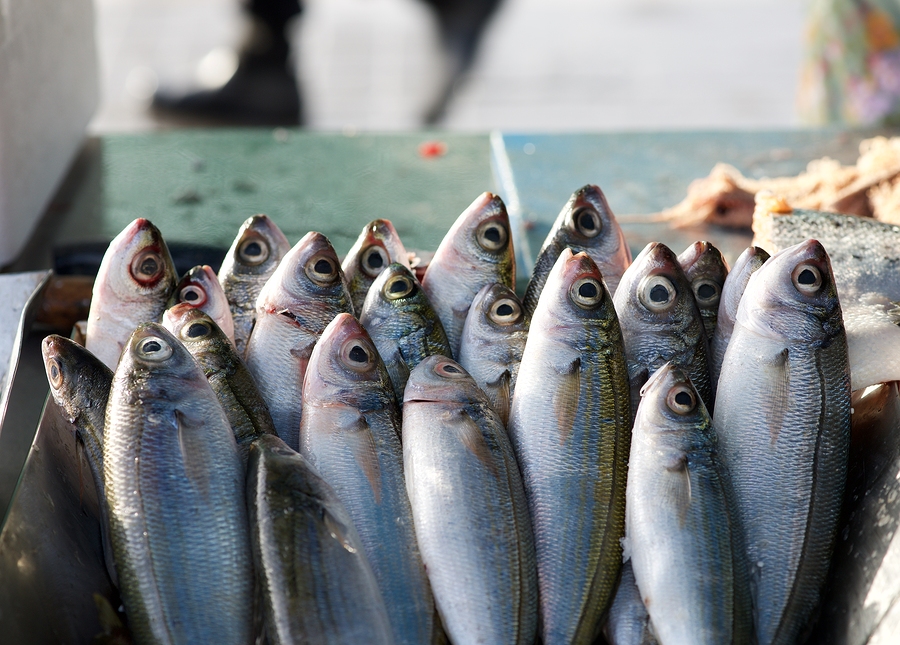Raw fish is incredibly beneficial to dogs. It is an excellent whole food and is full of healthy omega-3s.
While in some parts of the world there are fish that are not recommending for eating, throughout North America you can find an array of fresh fish to add to your raw fed dog’s diet.
What to Feed: Fish can be fed as whole prey. Salmon, trout, bass, blackfish, whiting, mullet, etc., can all be given to your raw fed dog.
However, there are some things to keep in mind.
Today many fish (mainly saltwater fish) are contaminated with industrial chemicals like PCBs, dioxins, and pesticides. These toxins are absorbed by small ocean plants and animals at the low end of the food chain. As larger ocean creatures consume these contaminated plants and prey the toxins accumulate and become more concentrated in the bodies of the bigger fish.
As a result, the larger the fish, the heavier laden it is with toxins. These types of fish include tuna which is known to contain high levels of mercury. So, when feeding fish, feed those as close to the bottom of the food chain as possible.
Also keep in mind that canned fish is a poor substitute and should not be fed as it is generally high in sodium and has added preservatives.
Finally, fish such as catfish and tilapia are high in omega-6 fatty acids. When feeding fish choose those that are high in omega-3s to balance out the omega-6s found in factory-farm raised meats such as beef, pork and lamb that are likely also a part of your raw fed dog’s diet.
How to Feed: Dogs experiencing fish for the first time will likely be a bit unsure of it. While you eventually want to work your way up to feeding whole fish (scales, head, guts and all) you should start by feeding small bites. As your dog adjusts feed bigger and bigger pieces until you’re able to feed fish whole.
Remove any sharp scales, barbs, fins, etc. and freeze for 1-2 months before feeding to kill parasites (discussed in detail below).
How Much to Feed: Feeding raw fish 2-3 times a week provides your dog with a healthy balance of proteins. Fish shouldn’t be a staple of your dog’s diet but can account for about 10-30%.
Its many healthful benefits aside, there are three main parasites in fish that can potentially cause your dog harm. Let’s take a look at each and discuss the proper precautions you can take to avoid these parasite risks.
Flukes
For the most part, flukes are harmless to dogs once fish has been frozen for 1-2 months before feeding.
However, Pacific Northwest trout and salmon can contain a fluke that causes infection and, if untreated, death. This fluke (specific to the Pacific Northwest) cannot be killed by freezing. Avoid feeding these fish as they can potentially cause serious harm to your dog.
Roundworms
Specifically, wild salmon may contain roundworms, but farm raised salmon rarely does.
However, farmed fish are generally fed growth hormones and contain residues of drugs. Fish farms are also very often owned by large corporations that recycle human foods. The results of farm raised fish eating recycled, rancid foods are damaged cholesterol and trans fatty acids.
In other words, feed wild caught fish.
Tapeworms
Tapeworm is the biggest threat when feeding raw fish. Tapeworms are found in the internal organs and body cavities of the fish. You can avoid them by gutting the fish, but you will lose the benefit of the nutrition from the organs.
Fortunately, freezing fresh fish for 1-2 months prior to feeding will kill these parasites.
Recap: When feeding your dog raw fish always freeze 1-2 months prior to feeding, feed fish on the low end of the food chain to avoid high concentrations of heavy metals, feed as whole prey (minus any sharp fins, barbs or scales) and feed as many as 2-3 times per week.
Not able to get your hands on fresh fish? Feed a fish oil instead.
Recommended: Grizzly Salmon Oil
